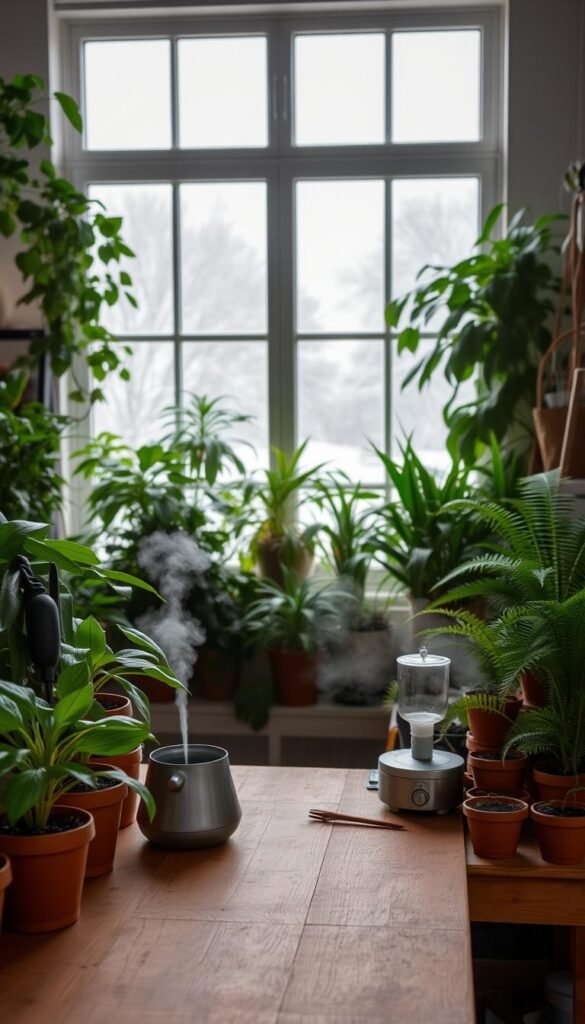When temperatures drop, your leafy companions need special attention. Many houseplants enter a rest period as daylight fades, slowing their growth dramatically. This seasonal shift means your usual plant care routine requires thoughtful adjustments to keep roots healthy and leaves vibrant.
Dry air from heaters and shorter days create unique challenges. Windows that once provided perfect light might now expose plants to chilly drafts. Soil takes longer to dry out, making overwatering the top threat to your collection’s survival.
Successful cold-weather care focuses on three key elements: moisture control, light optimization, and stable temperatures. You’ll want to space out watering sessions more than you might expect – sometimes waiting three weeks between drinks. Rotate pots regularly to ensure all sides receive scarce sunlight.
Remember, most tropical varieties prefer consistent conditions. Grouping plants together helps maintain humidity levels naturally. With simple tweaks to your approach, you can create a snug environment that mimics their preferred habitat until spring arrives.
Understanding Winter Challenges for Your Indoor Garden
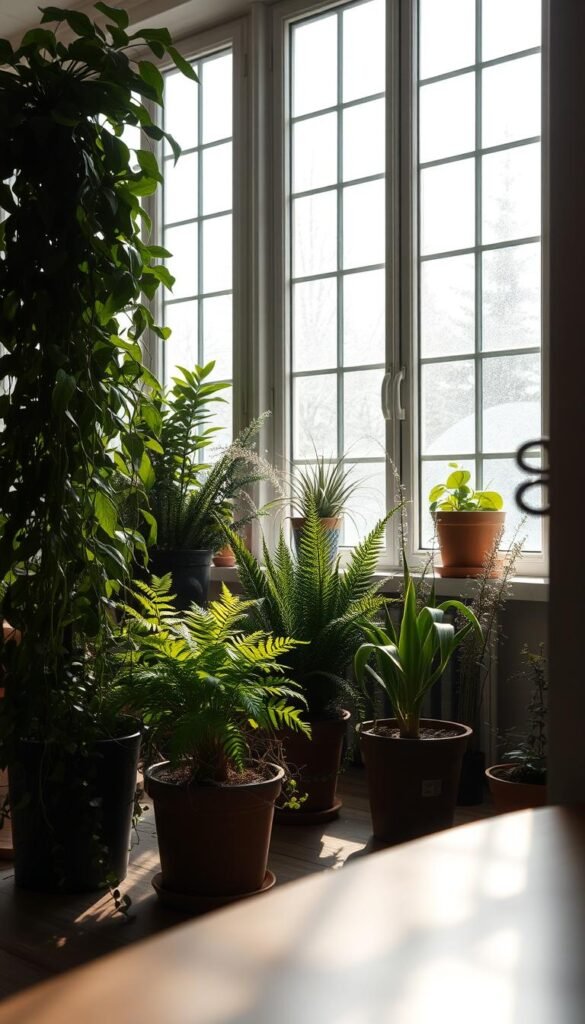
Cold months transform your home’s environment in ways that test even resilient greenery. Three key factors work against your leafy friends: dwindling sunlight, unstable temperatures, and moisture-sapping air.
Light Levels Drop Dramatically
Your plants receive only 8-10 hours of weak sunlight daily during winter months – half the intensity of summer rays. South-facing windows lose their magic, forcing light-loving species to stretch awkwardly toward faint glows. Pale leaves and stunted growth signal this light starvation.
Windows Become Temperature Traps
Glass surfaces create microclimates that swing 10-15°F colder than room temperatures after dark. This chill shocks roots and triggers yellowing leaves. Tropical varieties suffer most – their native habitats never dip below 60°F.
Heating Systems Steal Moisture
Forced-air systems create desert-like dryness, plunging humidity to 10-20%. Crispy leaf edges and sudden wilting reveal your houseplants’ distress. This aridity combines with other stressors, creating survival challenges for moisture-craving species.
| Factor | Summer Conditions | Winter Reality |
|---|---|---|
| Daily Light Exposure | 14-16 hours bright light | 8-10 hours weak glow |
| Window Temperatures | Consistent with room | 10-15°F colder at night |
| Air Humidity | Natural 40-60% | Drops below 20% |
Adjusting Watering Practices for Winter Dormancy
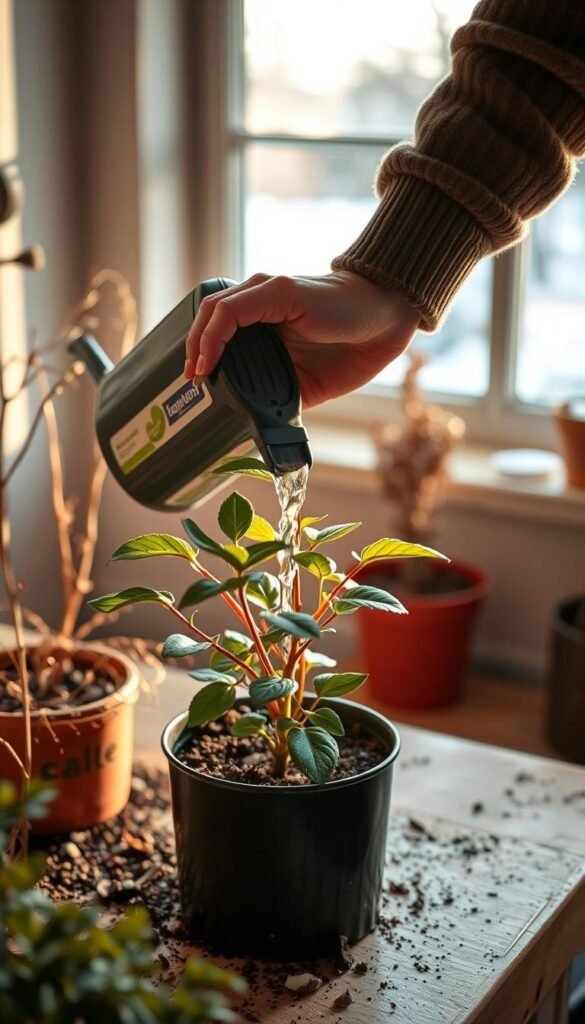
Shorter days mean your leafy friends drink less—adjust accordingly. Dormant roots absorb moisture slower, turning routine care into a delicate balancing act. Overwatering now ranks as the top threat to houseplants, with soggy soil triggering root rot faster than summer’s heat ever could.
Reducing Frequency and Volume
Cut back watering sessions by half during cold months. That fern guzzling weekly drinks in July? It might thrive on monthly sips now. Always probe the soil 2 inches deep—surface dryness fools many gardeners into drowning their greenery.
Swap guesswork for precision tools. Bamboo skewers reveal hidden dampness better than fingertips. If it emerges clean, water sparingly. Remember: plants need 30% less liquid when resting, so reduce both quantity and frequency.
Using Room Temperature Water
Icy tap water shocks dormant roots like a polar plunge. Let liquids sit until they match your home’s ambient warmth. This simple step prevents stress in moisture-sensitive species like peace lilies.
Watch for deceptive signs. Crispy leaf edges usually scream for humidity boosts, not more hydration. When in doubt, wait three extra days—soil retains moisture longer in cooler indoor air.
Optimizing Light and Placement for Indoor Plants
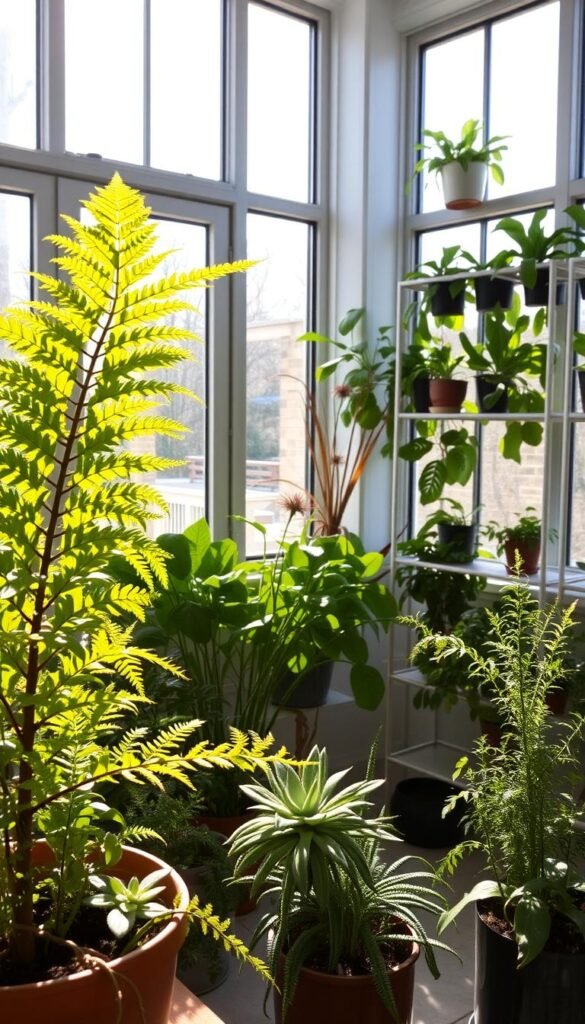
Winter’s pale sunshine demands creative solutions to keep your collection energized. The weaker rays offer new opportunities – species that fried in summer can now bask safely near glass. Strategic positioning becomes your secret weapon against the season’s gloom.
Sunlight Rotation Tactics
South-facing windows become prime real estate during shorter days. Rotate pots weekly so all sides receive equal exposure. Dust-free glass matters – a quick clean boosts light penetration by 25%.
| Season | Light Strategy | Plant Placement |
|---|---|---|
| Summer | Filtered light | 3-5 ft from window |
| Winter | Direct exposure | On windowsills |
Artificial Light Solutions
When natural light fades, quality grow lights become essential. Position Sansi units 18 inches above foliage for 8 hours daily. Group high-light species like succulents under shared fixtures to save energy.
Monitor your greenery’s response. Leggy growth signals need for closer bulbs, while bleached leaves suggest moving lights higher. With these adjustments, your indoor plants will power through winter’s dimmest days.
Controlling Humidity and Temperature for a Cozy Garden
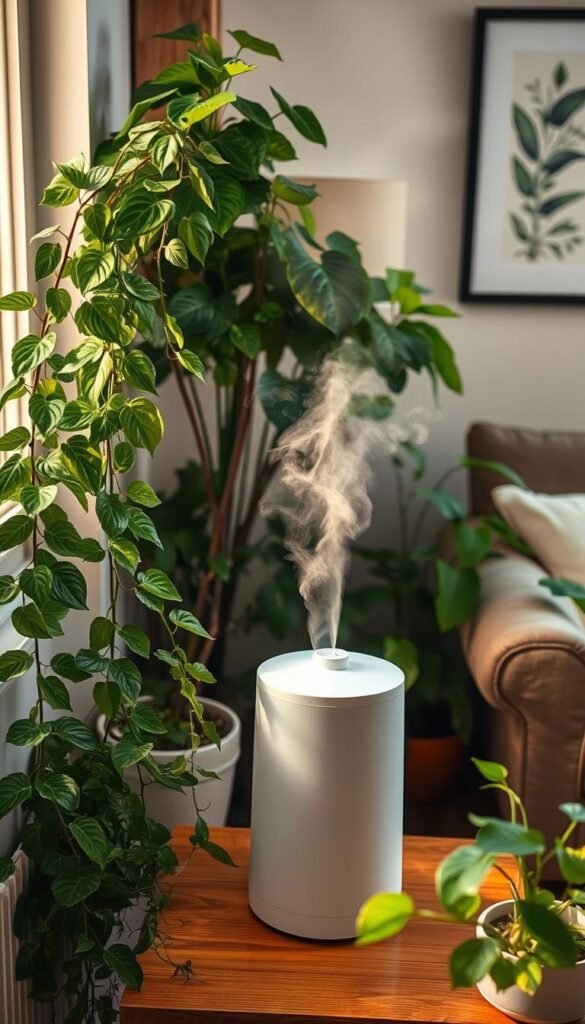
Balancing moisture and warmth becomes vital for thriving greenery during colder seasons. Heating systems battle the chill but create desert-like air that stresses tropical varieties. Smart positioning and simple tools help recreate jungle-like conditions your plants crave.
Grouping Strategies That Work
Cluster your plants to form natural humidity hubs. As leaves release moisture through transpiration, neighboring specimens benefit. Place pebble trays filled with water beneath clusters – evaporation boosts local humidity by 15-20%.
Danger Zones to Avoid
Keep greenery 3 feet from heat vents and radiators. These hotspots blast dry air that crisps leaves within days. Drafty windows pose equal risks – move specimens before night temperatures plunge.
Thermostat Management Made Simple
Most indoor plants thrive at 68-72°F during active day hours. Let temperatures dip 5-8 degrees at night to mimic natural cycles. Portable humidifiers like Pure Enrichment models offer targeted relief without fogging up your home.
| Humidity Solution | Effectiveness | Effort Level |
|---|---|---|
| Plant Grouping | +10-15% RH | Low |
| Pebble Trays | +15-20% RH | Medium |
| Room Humidifier | +25-40% RH | High |
Monitor conditions with affordable hygrometers – aim for 45-55% humidity near plant clusters. Remember: consistent temperature matters more than perfect numbers. Sudden swings stress roots more than gradual changes.
Maintaining Plant Health with Cleaning and Pest Prevention
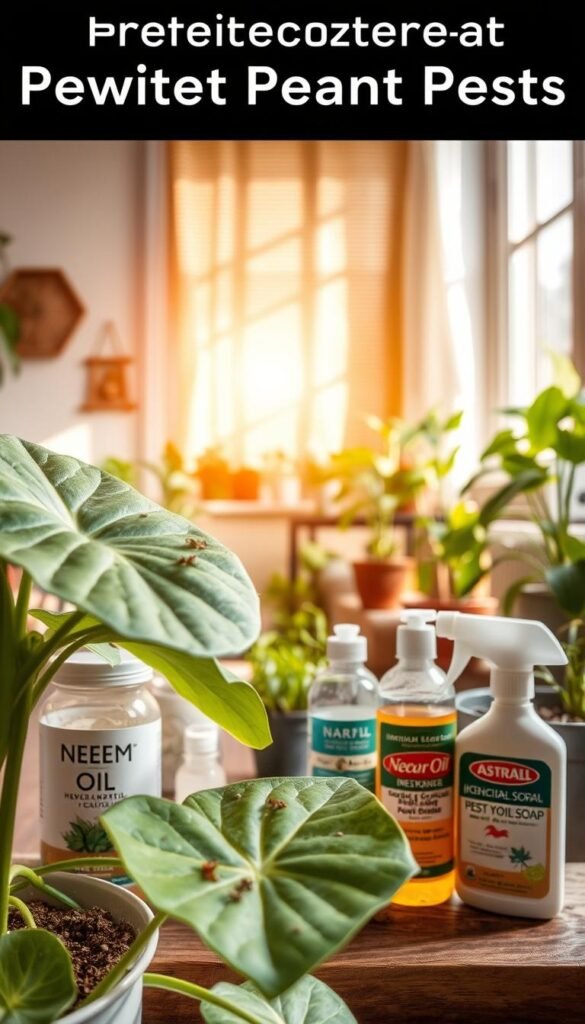
Winter’s dry air and dim conditions make your greenery more vulnerable to hidden threats. Dust-coated leaves struggle to absorb scarce sunlight, while heating systems create perfect environments for sneaky pests. Addressing these challenges helps your collection stay resilient through the coldest months.
Boosting Light Absorption Through Clean Leaves
Dust layers act like sunscreen for your plants, blocking up to 30% of available light. Gently wipe broad leaves weekly using microfiber cloths dampened with filtered water. Support each leaf from below to prevent tearing delicate surfaces.
For fuzzy-leafed varieties like African violets, use soft makeup brushes. Shower smaller specimens monthly under lukewarm water – this rinses dust from hard-to-reach crevices. Always let foliage dry completely before returning to dimmer spots.
Spotting Trouble Before It Spreads
Check leaf undersides weekly during winter months. Spider mites leave telltale webbing, while mealybugs appear as cottony clusters. Isolate affected plants immediately and treat with neem oil solutions.
- Quarantine new additions for four weeks
- Use yellow sticky traps for fungus gnat alerts
- Apply insecticidal soap at first pest sightings
Remember: stressed indoor plants attract more invaders. Keeping leaves clean and conditions stable forms your best defense against winter’s twin threats.
Tips for Maintaining an Indoor Winter Garden: Keeping Plants Cozy Year-Round
As daylight dwindles, your indoor greenery enters a phase requiring mindful nurturing. This seasonal shift calls for strategic care adjustments that honor your plants’ natural rhythms while countering winter’s harsh effects.
Master moisture control by letting soil dry completely between waterings—sometimes stretching to three-week intervals. Pair this with weekly leaf inspections, wiping surfaces to maximize light absorption. Rotate pots near south-facing windows weekly, supplementing with full-spectrum bulbs when needed.
Create microclimates by clustering plants on pebble trays. This boosts humidity naturally while insulating roots from temperature swings. Hold off on fertilizing until spring; dormant roots can’t process nutrients efficiently.
Stay vigilant against pests attracted to stressed foliage. A simple neem oil solution applied during cleaning sessions prevents most infestations. Resist repotting urges until active growth resumes—your plants prefer snug containers during their rest period.
With these focused winter strategies, you’ll maintain vibrant greenery ready to thrive when warmer time returns. Your attentive care now sets the stage for a flourishing year ahead.

